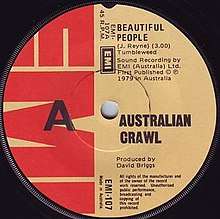Beautiful People (Australian Crawl song)
"Beautiful People" is the 1979[1] debut single released by Australian rock band Australian Crawl and later appeared on their debut album The Boys Light Up (1980). The song was written by James Reyne and Mark Hudson,[2] former bandmates.[3]
| "Beautiful People" | ||||
|---|---|---|---|---|
 | ||||
| Single by Australian Crawl | ||||
| from the album The Boys Light Up | ||||
| A-side | "Beautiful People" | |||
| B-side | "Man Crazy" | |||
| Released | August, 1979 | |||
| Recorded | AAV Studios (Melbourne, Victoria) | |||
| Genre | Pop/rock | |||
| Length | 2:56 | |||
| Label | EMI | |||
| Songwriter(s) | James Reyne, Mark Hudson | |||
| Producer(s) | David Briggs | |||
| Australian Crawl singles chronology | ||||
| ||||
The music video for "Beautiful People" was filmed in 1979 at the then-maligned, dilapidated & graffitied (but now fixed up & heritage-listed) Bellevue House.
Australian Crawl caught the attention of Little River Band’s guitarist David Briggs, who helped them to a recording contract with EMI and produced their first single.[4] "Beautiful People" was released in August, 1979 and peaked at #22 on the Australian Singles Chart.[5]
The song satirised the vacuous elite of mid-1970s Melbourne's Toorak society:
I was just looking around at people who were putting on airs... It's pretension. It's everywhere, probably even more now. There's a complete culture surrounding it now, magazines devoted to it. It was a much simpler time, 1975.
— James Reyne, [6]
In 1975, Reyne was living in South Yarra, Victoria whilst attending Monash University and playing drums for Archie Slammit and the Doors.[6]
The Making of "Beautiful People" (1979) was a mini-documentary broadcast on Australian Broadcasting Corporation (ABC) TV pop show Countdown and featured Geoff Cox (later hosted Coxy's Big Break) guiding the audience from the studio sessions to the pressing of the 7" vinyl and finishing with Australian Crawl's performance on Countdown.[4]
The Crawl made a memorable debut on Countdown performing "Beautiful People" as Reyne appeared with both arms encased in plaster. He was also featured in the official music video with his arms in plaster. He had been hit by a car in Swanston St, Melbourne breaking bones in both wrists, an episode chronicled in the song "Indisposed".[4][7] Although "Beautiful People" only reached #22, it remains one of their most popular songs.[8]
Charts
| Chart (1979) | Peak Position [5] |
Weeks In |
|---|---|---|
| Australian Singles Chart | 22 | 25 |
References
- "Rate Your Music entry on "Beautiful People"". Retrieved 2008-03-02.
- "Australasian Performing Right Association". APRA. Archived from the original on 24 January 2008. Retrieved 2008-03-05.
- "Australian Crawl". Australian Rock Database. Magnus Holmgren. Archived from the original on 9 February 2008. Retrieved 2008-03-06.
- McFarlane, Ian (1999). Encyclopedia of Australian Rock and Pop. Allen & Unwin. ISBN 1-86448-768-2. Archived from the original (doc) on 2002-09-08. Retrieved 2008-03-01.
- Kent, David (1993). Australian Chart Book 1970-1992. St Ives, N.S.W.: Australian Chart Book. ISBN 0-646-11917-6. NOTE: Used for Australian Singles and Albums charting from 1970 until ARIA created their own charts in mid-1988.
- Carney, Shaun; Jeff Jenkins; Michael Dwyer; Chris Beck; Martin Flanagan; Alan Attwood (2004-08-28). "Songs of Melbourne". The Age. Retrieved 2008-03-18.
- "Countdown Club entry on Australian Crawl". ABC. Archived from the original on 19 February 2008. Retrieved 2008-03-02.
- "Triple M's Essential 2007 Countdown". Triple M. Archived from the original on 2008-11-20. Retrieved 2008-03-02.